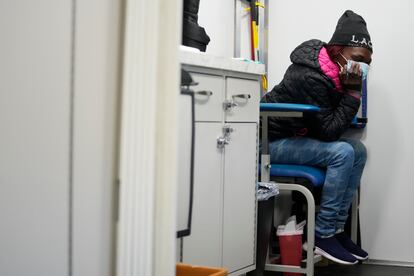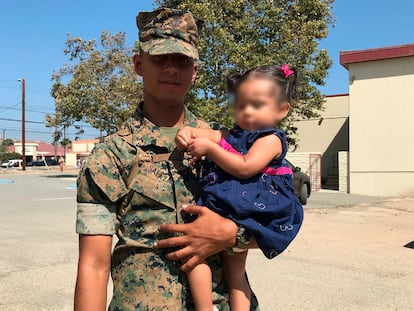Abstinence not required: How a Baltimore drug treatment program prioritizes saving lives
Baltimore’s overdose death rate is significantly higher than the statewide and nationwide averages, with more than 1,000 lives lost in 2020, the most recent data available

Anthony Kelly trudged through southwest Baltimore, each labored footstep a reminder of the roofing accident that left him with chronic pain and a raging opioid addiction several years after he returned home from serving in the Marines.
Doctors used metal plates to reconstruct his lower legs and Kelly spent months learning to walk again. So began his plodding journey into the depths of substance use disorder, a downward spiral that would gradually weaken his body and consume his mind.
After his prescribed painkillers ran out, Kelly turned to a combination of heroin and cocaine that sometimes cost $500 per day.
More than a decade later, his substance use is more manageable and less expensive, though it remains a controlling force in his life. He takes buprenorphine, a prescription medication that’s considered the gold standard for treating opioid addiction by reducing cravings and easing withdrawal symptoms.
He gets the medication through a mobile health clinic housed in a retrofitted van, which parks in some of Baltimore’s most drug-ravaged communities, including Kelly’s neighborhood. Doctors and nurses meet with patients, write prescriptions and provide basic wound care, hepatitis C treatment, packages of the overdose reversal agent naloxone and more, all free of charge.
The clinic exemplifies an ongoing shift in the nation’s approach to stemming overdose deaths, which surged during the pandemic to unprecedented heights as the potent synthetic opioid fentanyl replaced heroin in drug markets across the country. The so-called harm reduction model, which has received endorsement and funding from the Biden administration, offers potentially life-saving services to opioid users, without requiring abstinence in return.
Advocates say it acknowledges the importance of keeping people alive, first and foremost, while they confront the sometimes insurmountable challenges associated with recovery. Critics argue it enables illegal activity.
In Baltimore’s “Healthcare on the Spot” program, most patients continue using street drugs, but the vast majority report using less, according to clinic staff.
“Being an addict, it’s more complicated than people think,” said Kelly, 49. “We built this web we’re entangled in. We didn’t get here overnight and we’re not gonna get better overnight. You can’t just snap out of it.”
Baltimore’s overdose death rate is significantly higher than the statewide and nationwide averages, with more than 1,000 lives lost in 2020, the most recent data available. The city makes up about 10% of Maryland’s population but logs more than 35% of its overdose deaths.
“We should be thinking about harm reduction on a spectrum. Some people want to stop using, others want to use safer. This is about truly meeting people where they are,” said Dr. Letitia Dzirasa, who served as the city’s health commissioner until recently being appointed deputy mayor. “It’s also about reducing the stigma. Because this is a disease, not a moral failing.”
Buprenorphine, which received federal approval for treatment of opioid use disorder in 2002, binds to opioid receptors in the brain without producing a euphoric high. Often prescribed under the brand name Suboxone, the drug typically comes in orange strips that dissolve under your tongue.
Research shows it significantly reduces a person’s risk of overdose and death. Despite its effectiveness, a relatively small percentage of people experiencing opioid addiction are prescribed the medication. In contrast to methadone treatment, which is highly regulated and often requires patients to visit a clinic every day, buprenorphine prescriptions can last weeks or months.
In December 2022, federal lawmakers passed legislation that made it easier for doctors to prescribe buprenorphine, recognizing its life-saving potential. Drug overdoses nationwide have claimed more than 100,000 lives annually since 2020, with about two-thirds of them related to fentanyl.
Every Monday morning, the Spot van parks in west Baltimore’s Upton community, a historic Black cultural hub once known for its renowned jazz clubs, upscale shops and vibrant nightlife.
Now a shadow of its former self, the neighborhood is filled with visible impacts of the local drug trade: dealers doing business outside vacant buildings, their customers nodding drowsily on public benches, stumbling through alleys and trying to scrounge up enough money to make it through another day. Baltimore police cruisers routinely patrol the area, part of the city’s crime-fighting strategy to increase law enforcement presence in communities plagued by gun violence.
Less than a block from the van’s parking spot, a tangle of deflated balloons commemorates a January shootout that wounded three people and killed two, including a young mother who was waiting to pick up a takeout order when she and her children got caught in the gunfire.
The Spot program, which launched in 2018, operates under a partnership between the Baltimore City Health Department and the Johns Hopkins University School of Medicine. It typically serves about 900 patients a year. An estimated 40% of them have a recent history of intravenous drug use, almost 75% are Black and more than half are experiencing homelessness or housing instability.
Darryl Jackson Sr., who enrolled last year along with his adult son, said sometimes the clinic feels like the only source of stability in his life. He recently had to leave the apartment where he had been staying and was researching rental assistance programs, which are often mired in bureaucracy and hobbled by impossibly long waitlists.
Jackson, 58, said he can’t tolerate shelter environments because he’s a stickler for cleanliness. He takes pride in maintaining a neat appearance. After a career in construction, he still dresses almost exclusively in canvas work pants and sneakers.
But on the inside, he struggles to keep his addiction in check and stave off a growing feeling of hopelessness. He recently returned to the Spot van after some missed appointments.
“They care,” he said. “So I keep coming back.”
Sign up for our weekly newsletter to get more English-language news coverage from EL PAÍS USA Edition
Tu suscripción se está usando en otro dispositivo
¿Quieres añadir otro usuario a tu suscripción?
Si continúas leyendo en este dispositivo, no se podrá leer en el otro.
FlechaTu suscripción se está usando en otro dispositivo y solo puedes acceder a EL PAÍS desde un dispositivo a la vez.
Si quieres compartir tu cuenta, cambia tu suscripción a la modalidad Premium, así podrás añadir otro usuario. Cada uno accederá con su propia cuenta de email, lo que os permitirá personalizar vuestra experiencia en EL PAÍS.
¿Tienes una suscripción de empresa? Accede aquí para contratar más cuentas.
En el caso de no saber quién está usando tu cuenta, te recomendamos cambiar tu contraseña aquí.
Si decides continuar compartiendo tu cuenta, este mensaje se mostrará en tu dispositivo y en el de la otra persona que está usando tu cuenta de forma indefinida, afectando a tu experiencia de lectura. Puedes consultar aquí los términos y condiciones de la suscripción digital.
More information
Archived In
Últimas noticias
‘How does it feel to be a failure?’: Elizabeth Berkley’s journey from ‘Showgirls’ ridicule to vindication
The story of the Málaga virus: The code that haunted Google’s cybersecurity center director for 30 years
The impact of Ecuador’s mega-prison: A polluted river, cleared forests and military checkpoints
Corinne Low: ‘I’m more concerned about the female happiness gap than the gender wage gap’
Most viewed
- The low-cost creative revolution: How technology is making art accessible to everyone
- Christian Louboutin: ‘Young people don’t want to be like their parents. And if their parents wear sneakers, they’re going to look for something else’
- All the effects of gentrification in one corner of Mexico’s Colonia Roma
- Liset Menéndez de la Prida, neuroscientist: ‘It’s not normal to constantly seek pleasure; it’s important to be bored, to be calm’
- Christmas loses its festive spirit: ICE fears cast shadow over religious celebrations










































